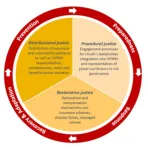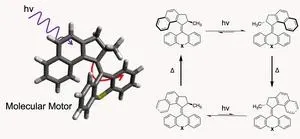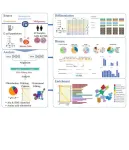(Press-News.org) The frequency and severity of wildfires have become increasingly alarming in recent years, substantially due to the effects of climate change. Rising global temperatures, altered weather patterns, and prolonged droughts are all consequences of climate change that contribute to the heightened risk of wildfires.
The 2019-2020 Australian wildfires demonstrated that compound climatic events – long-lasting record high temperatures combined with record low precipitation – can lead to unprecedented large-scale impacts. These fires affected 80% of the people living in Australia in some way. As a result, there were disagreements about who should have access to reconstruction funding, and who should move to safer areas. In fact, these disagreements reflect different perceptions by different stakeholders of what is just in terms of outcomes and processes.
While there is some literature focusing on justice aspects in relation to management of other hazards, such as floods, hurricanes, and earthquakes, existing literature on wildfire risk management has paid little attention to individual justice issues so far. In a new article, published in Nature Climate Change, IIASA researchers, together with colleagues from the Fraunhofer Institute for Technological Trend Analysis (INT) and the Forest Science and Technology Centre of Catalonia (CTFC), argue that three domains of justice need to be considered for the transition to integrated and inclusive wildfire risk management approaches: distributional justice, procedural justice, and restorative justice.
“The distributional justice aspect focuses on who should bear the costs and benefits of wildfire risk management. Procedural justice looks at policy selection and which stakeholders are heard when developing wildfire risk management measures. Restorative justice addresses restoration and compensation mechanisms, including insurance,” explains lead author Thomas Schinko, a senior IIASA researcher who also leads the Equity and Justice Research Group in the IIASA Population and Just Societies Program. “These three dimensions of justice are considered key in the fields of environmental, climate, and disaster justice.”
The framework’s objective is to provide a comprehensive categorization of the three dimensions of justice against the four phases of the wildfire risk management cycle: 1. Prevention, 2. Preparedness, 3. Response, and 4. Recovery and Adaptation.
“The framework shows that distributional, procedural, and restorative justice challenges arise along all four wildfire risk management phases, and across social, economic, cultural, and ecological dimensions that impact the risk management process,” notes Schinko.
“They are linked to trade-offs arising from actions and inactions influencing hazards, exposures and vulnerabilities, and may lead to conflicts among stakeholders,” adds coauthor Claudia Berchtold, a senior researcher at Fraunhofer INT.
Eduard Plana, a coauthor and Department Head at the Forest Science and Technology Centre of Catalonia (CTFC), stresses that “operationalizing integrated and just approaches to wildfire risk management is urgently needed as societies deal with a fundamentally changing wildfire risk context, while at the same time scaling up their climate change mitigation ambitions.”
Schinko and his colleagues argue that more inclusive and integrative wildfire risk management strategies should also be connected to the Just Transition discourse. In recent years, the concept has gained traction with reference to meeting climate goals by ensuring that everyone – all communities, workers, and social groups – are brought along in the pivot to a net-zero future, leaving no one behind.
“This framework helps us to identify justice aspects across all four wildfire risk management phases. It sets out the conceptual basis for further in-depth analyses, such as focusing on how wildfires affect indigenous communities. Additionally, it provides a foundation for risk management and governance practices to include important distributional, procedural, and restorative justice considerations. This is particularly relevant when working towards a Just Transition to more holistic wildfire risk management strategies and approaches,” concludes Schinko.
Reference
Schinko, T., Berchtold, C., Handmer, J., Deubelli-Hwang, T., Preinfalk, E., Linnerooth-Bayer, J., Scolobig, A., Serra, M., Plana, E. (2023). A framework for considering justice aspects in integrated wildfire risk management Nature Climate Change DOI: 10.1038/s41558-023-01726-0
Researcher contact
Thomas Schinko
Research Group Leader and Senior Research Scholar
Equity and Justice Research Group
Population and Just Societies
schinko@iiasa.ac.at
Press Officer
Bettina Greenwell
IIASA Press Office
Tel: +43 2236 807 282
greenwell@iiasa.ac.at
About IIASA:
The International Institute for Applied Systems Analysis (IIASA) is an international scientific institute that conducts research into the critical issues of global environmental, economic, technological, and social change that we face in the twenty-first century. Our findings provide valuable options to policymakers to shape the future of our changing world. IIASA is independent and funded by prestigious research funding agencies in Africa, the Americas, Asia, and Europe.
END
This study has attracted the attention of the international scientific community and opens up unprecedented perspectives in the formation of frequency combs: it predicts the existence of two-dimensional optical rules, more complex than the one-dimensional ones used so far and offering unprecedented versatility in a wide range of applications.
Applications in communications, spectroscopy, or computing
Frequency combs have a wide range of applications, particularly in the field of communications. According to the authors of the study, these combs allow large amounts of information to be transmitted through optical fibres in a ...
Orangutans are dependent on their mothers longer than any other non-human animal, nursing until they are at least six years old and living with her for up to three more years, learning how to find, choose, and process the exceedingly varied range of foods they eat. But how do orangutans that have left their mothers and now live far from their natal ranges, where the available foods may be very different, decide what to eat and figure out how to eat it? Now, an international team of authors has shown that in such cases, migrants follow the rule ‘observe, and do as the locals do’.
“Here we show evidence that migrant orangutan males ...
The process of converting DNA to proteins through an RNA is far from straightforward. Of the several types of RNA involved in the process of protein synthesis, a few may be edited mid-way. In mammals, RNA editing mostly involves converting adenosine (A) to inosine (I) through deamination, which can result in a wide range of effects. For example, A-to-I conversion can regulate gene expression in different ways and significantly alter the final synthesized protein.
While RNA editing is an essential biological process, it is also a key underlying mechanism in some diseases, including cancer. Thus, scientists have created large-scale databases documenting RNA editing sites in various human ...
The community of microbial predators influences the composition of the bacterial community in wastewater. This explains seasonal variations in the microbial community that affect the efficiency of water treatment. This is the result of a study conducted by Nils Heck and PD Dr Kenneth Dumack from the University of Cologne’s Institute of Zoology. The study has been published under the title ‘Microeukaryotic predators shape the wastewater microbiome’ in the journal Water Research.
In wastewater treatment plants, a precisely coordinated interaction of different microorganisms takes place in order to effectively ...
University of Virginia School of Medicine researchers have discovered how the cells that let us hear can repair themselves after being damaged. That important insight could benefit efforts to develop new and better ways to treat and prevent hearing loss.
“Hair cells” found in the inner ear, are important both for our ability to hear and our sense of balance. They are known as hair cells because the cells are covered in hair-like structures that serve as mechanical antennas for sound detection. When auditory hair cells are killed, as we learn in school, they are ...
INDIANAPOLIS – Information on the nonmedical factors that influence health outcomes, known as social determinants of health, is often collected at medical appointments. But this information is frequently recorded as text within the clinical notes written by physicians, nurses, social workers, and therapists.
Researchers from Regenstrief Institute and Indiana University Fairbanks School of Public Health recently published one of the first studies in which natural language processing was applied to social determinants of health. The researchers developed three new natural language processing algorithms to successfully extract information from text data related to housing ...
ROCKVILLE, Md. – July 10, 2023 – The Association for Molecular Pathology (AMP), the premier global molecular diagnostic professional society, today published consensus recommendations to aid in the design and validation of clinical CYP3A4 and CYP3A5 genotyping assays, promote standardization of testing across different laboratories, and improve patient care. The manuscript, “CYP3A4 and CYP3A5 Genotyping Recommendations: A Joint Consensus Recommendation of the AMP, Clinical Pharmacogenetics Implementation Consortium (CPIC), College of American Pathologists (CAP), Dutch Pharmacogenetics Working Group (DPWG) of the Royal Dutch Pharmacists ...
NEW YORK, NEW YORK, July 10, 2023 – First Ladies from countries across Africa and experts from the Columbia University Mailman School of Public Health will meet the week of July 10, 2023 to discuss current trends, critical research, and sustainable, evidence-based approaches to promote population health and well-being. From July 10th to the 13th, First Ladies and their senior advisors will participate in an executive leadership program to advance critical health and development issues in their countries and regions, including communicable and chronic disease ...
Artificial intelligence has transformed how industries and organizations operate, putting data professionals in high demand. To meet this increasing need, Carnegie Mellon University recently launched an online Graduate Certificate in Computational Data Science Foundations program.
"Everything we teach will translate into skills that enable mobilization of data for significant impact in your organization," said Carolyn Rosé, the faculty program director and a professor in both the Human-Computer ...
SEATTLE, Wash. – A boom in alcohol sales during the pandemic appears to have had dire consequences for some as hospital admissions for alcohol-related hepatitis, a life-threatening liver inflammation, increased dramatically, according to a study of national hospitalization data.
Researchers found increasing cases of the alcohol-related liver illness from 2016 through 2020, but the rise was particularly pronounced the year COVID-19 arrived in the U.S. in 2020, which saw a 12.4% increase over 2019 levels. It was worse in younger patients, ages 18 to 44, a group that had a nearly 20% ...





